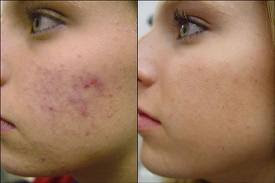Clinical Symptoms Of Acne
Acne (acne) is a clinically
and heterogeneous group of lesions of the sebaceous glands, which proceeds with
the formation of comedones and inflammatory skin problem.
Allocate acne newborn,
infant, youth and late. Baby acne occurs during hormonal crisis as a time of
hypertrophy of the sebaceous glands and miliums.
Infant acne is observed in
children aged 6 months to 2-3 years of age are usually inflammatory in nature
and develop against transient disorders of inhibition of endogenous steroids.
Later acne appear aged 30-40 years against the pathology of adrenal
hyperandrogenism or reproductive glands, which is accompanied by metabolic disorder
in sebocytes, increased sensitivity of the receptors to testosterone
metabolites, as well as other changes that affect the development of acne.
Teenage acne are found in
80-90% of adolescents. Most of them are 18-20 years to reverse the development
of acne, 20% of patients, this process is delayed, and in 1.5% of men and 0.4%
of women the disease becomes severe during the formation of the deep scars and
pigmentation.
 |
Learn How To Get Started and look like Vince! |
Factors affecting the development of the youth of
acne:
Violation of the quality and quantity of
sebum;
Changes in hormonal status;
Abnormal keratinization of
the follicular canal;
Intensive colonization
propionbaktery acne sebaceous glands;
Moreover, the symptoms are
also indicated with the development of inflammatory reactions in the Perifollicular
areas with Genetic predisposition. Quality and quantity of sebum have a
significant impact on the development of acne. Sebum lipids consist of two
components: the epidermal lipids and lipids are synthesized in the sebaceous
glands.
When there is a reduction of
the content of epidermal lipids and increased secretion of lipids in the
sebaceous glands of the increase in their follicular cholesterol sulfate. The
latter enhances the adhesion of corneocytes and largely contributes to a
retentive hyperkeratosis, which is the cause of abnormal keratinization mouth
sebaceous follicle. When acne occurs as a quantitative change of sebum, which
is an important condition for the formation of acne and is often correlated
with disease severity of acne.
No comments:
Post a Comment